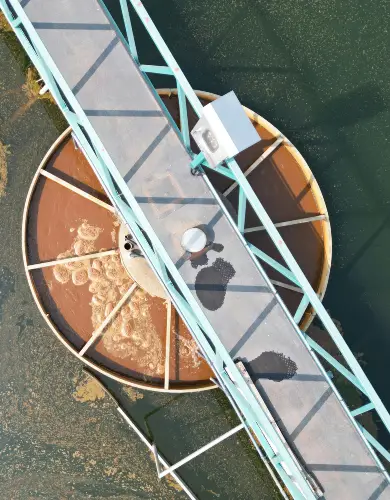How the National Transmission System transports gas across Britain
Operating at pressures of up to 85 bar, the National Transmission System (NTS) is a national pipeline that transports up to 500 million cubic metres of gas per day, supplying homes, industry, and gas-fired power stations across Britain.
Natural gas powers around one-third of Britain’s energy needs, and at the core of this delivery system lies the vast, high-capacity NTS pipeline network that stretches over 4,000 miles.
This guide explores how the NTS works. Here’s what we cover:
- What is the National Transmission System?
- How does the National Transmission System transport gas?
- Capacity, balancing and demand fluctuations on the National Transmission System
- How does the National Transmission System ensure gas safety and reliability?
- How the NTS impacts business gas bills
What is the National Transmission System?
The National Transmission System is the network of high-capacity gas pipelines and compressor stations in Great Britain.
It receives natural gas at the locations where it is delivered to Great Britain from North Sea gas fields, LNG terminals, and interconnecting pipelines from Europe.
Gas is transported through 4,700 miles of high-grade steel pipelines, ranging from 0.6 to 1.2 metres in diameter, operating at extremely high pressures to efficiently move large quantities of natural gas.
The NTS transports gas to places where it is used: gas-fired power stations, large industrial users, or regional gas distribution networks that connect to individual homes and businesses.
Here’s a map of the National Transmission System:

Source: National Gas, network route map
The National Transmission System is operated by National Gas, which manages the pipeline system to ensure a safe, and reliable gas supply to customers nationwide.
The NTS is an integral part of the UK’s gas supply infrastructure and plays a critical role in meeting the country’s energy needs.
How does the National Transmission System transport gas?
The National Transmission System enables the high-capacity transmission of natural gas through the following steps.
1. Gas entry into the NTS
Natural gas enters the National Transmission System at the following high-pressure entry points:
- Offshore fields – North Sea gas via terminals such as St Fergus, Bacton, Easington, etc.
- LNG import terminals – Isle of Grain, South Hook, Dragon
- Interconnectors – Pipelines from Belgium and the Netherlands
- Gas storage facilities – Centrica’s Rough facility, Hornsea salt cavern, etc.
Before entering the NTS, the gas may need to be treated and compressed to meet the required quality and pressure standards. Gas processing plants and compressor stations near the entry points typically carry out this work.
2. Long distance transmission via pipelines
The gas travels through the high-pressure steel pipeline network across Britain.
National Gas controls the flow of gas through the network. It uses real-time telemetry to manage direction, ensure safety, and keep distribution efficient.
Along the pipeline, compressor stations are placed every 80 to 100 kilometres. These compressors maintain the pressure of gas in the system and help control the direction of flow.
3. Delivery to exit points
Gas leaves the NTS at various exit points, at locations near the end-users of gas:
- Large industrial users
- Gas-fired power stations
- Regional Gas Distribution Networks
Gas pressure is reduced at the offtake points using a pressure reduction station.
Before entering a regional gas distribution network, the natural gas is odorised for safety detection. It is then distributed over short distances and at low pressures to local homes and businesses.
💡Gas transmission refers to transporting gas through the high-capacity NTS, while gas distribution refers to transporting gas through regional low-capacity networks.
Capacity, balancing and demand fluctuations on the National Transmission System
Balancing is a core operational process on the NTS, ensuring that the amount of gas entering the system matches the amount leaving it.
National Gas, the operator of the NTS, must keep supply and demand in equilibrium to maintain safe operating pressures within the pipeline.
The team at National Gas uses modelling and real-time data from the NTS to predict demand based on:
- Seasons and temperature – The colder the weather, the more gas boilers are used, increasing the delivery of gas onto the regional distribution networks.
- Wind farm activity – On still days when UK wind farms don’t generate electricity, Britain’s gas power stations run at full capacity, consuming more gas.
- Historical trends – Gas demand follows a regular daily and weekly pattern based on the timing of industrial activity and consumer demand.
National Gas trades on the wholesale gas market to increase or decrease the volume of gas on the pipeline.
When gas pressure needs to rise, National Gas will purchase gas for immediate delivery from importers, delivered via interconnector pipelines with Europe.
When gas pressure needs to decrease, National Gas will sell gas for immediate delivery, which can be exported to Europe.
Gas storage facilities on the National Transmission System
Gas storage facilities on the NTS also provide a way for National Gas to make adjustments to the pressure of gas on the network. These facilities can store gas during the summer months when demand is low, and inject it back into the NTS during periods of high demand.
There are two main types of gas storage on the NTS:
- Salt cavern – Underground cavities created by dissolving salt formations, which are ideal for storage that can quickly deliver high volumes of natural gas into the NTS.
- Depleted field – Former gas fields that have been depleted of their natural gas and repurposed for long-term gas storage.
These gas storage facilities help National Gas maintain balance on the NTS by allowing gas to be injected or withdrawn on demand.
National Transmission System capacity
The NTS has a maximum daily throughput of approximately 10,000 GWh per day, which equates to 500 million cubic metres of gas per day.
This is approximately four times higher than the average daily gas consumption in Britain. It allows the system to manage peaks in demand during the winter months when gas consumption rises.
Capacity assessments are regularly conducted by National Gas to ensure that the NTS has sufficient capacity to meet demand and avoid disruptions under all operating conditions.
The capacity assessment supports investment decisions, helping to determine when new pipelines or compressor stations are required to support the demand for gas.
How does the National Transmission System ensure gas safety and reliability?
Safety is paramount on the National Transmission System because it transports natural gas, which is under extremely high pressure and is flammable.
Here are the steps National Gas takes to ensure the safe and reliable transmission of natural gas.
Monitoring and real-time control
The National Gas Control Centre operates 24/7 to oversee the entire network. The team uses a Supervisory Control and Data Acquisition (SCADA) system to monitor continuously:
- Gas pressures
- Temperatures
- Flow rates
- Equipment status
The system automatically alerts the control centre if any values fall outside safe parameters, allowing for reactive maintenance of issues.
Emergency shutdown and response
The NTS has an automated Emergency Shut Down system to isolate faults rapidly.
The pipeline includes a series of block valves every 10–30 km that allow sections of the pipe to be isolated in the event of a leak or another emergency.
During an incident, gas from an isolated section can be vented safely using a flare stack or a venting chimney.
Emergency response teams are on standby to manage incidents.
Robust design and redundancy
The pipelines used in the NTS are built to high engineering and safety specifications that comply with strict safety requirements from the UK government’s Health and Safety Executive.
The network is also designed with multiple routes to provide redundancy. If there is a problem with a specific part of the pipeline, gas can usually be rerouted to reach its destination.
Regular maintenance and inspection
The team at National Gas regularly inspects its pipeline network to ensure it is in good condition and can operate safely and reliably. Scheduled inspection includes sending devices called “pigs” through the inside of the pipes to clean internal surfaces, inspect for corrosion, cracks and dents, and remove debris.
💡The term “pig” originated from the squealing sound early cleaning devices made as they scraped along the internal pipe walls.
How the NTS impacts business gas bills
A business gas bill covers more than just the fuel; it includes extraction, safe transport, and network maintenance and in Britain always includes the cost of using the National Transmission System.
National Gas, the operator of the NTS, charges gas suppliers and shippers Gas Transmission and Transportation Charges, which cover:
- Maintaining pipelines and compressor stations
- Investments in upgrades and resilience
- Operating the control centre and safety systems
Gas Transmission and Transportation Charges are set annually and include a unit price per kWh transported through the pipeline, and a fixed price per day for using the NTS.
These charges are passed on to business gas suppliers, who incorporate them into business energy contract rates.
Although NTS charges are unavoidable, gas suppliers are free to add a mark-up to these underlying costs, meaning businesses can save on bills by simply choosing the cheapest supplier. Find a cheaper supplier for your business today using our business gas comparison service.
Regulation of the National Transmission System
The National Transmission System is regulated by Ofgem (the Office of Gas and Electricity Markets), which is the independent regulatory body responsible for ensuring that gas and electricity markets in the UK are competitive, efficient, and consumer-focused.
Ofgem sets the regulatory framework for the NTS and oversees the system’s operation to ensure it runs safely, securely, and efficiently.
There is only one high-capacity gas pipeline in Britain, creating a natural monopoly that all gas suppliers must pay to use. Because of this, Ofgem applies price controls to the NTS to ensure that the charges for using the system are fair, reasonable, and transparent.
The annual NTS prices are set several years in advance and take into account factors such as the cost of maintaining and upgrading the system, as well as the cost of financing the capital investments needed for its expansion.
The future of the National Transmission System
As the UK continues to move towards carbon neutrality by 2050, the NTS will evolve from its current role of delivering natural gas to becoming a key component of a decarbonised energy backbone.
Key priorities for the future of the NTS include:
- Green hydrogen transportation – The UK is beginning to develop green hydrogen production capacity, where excess renewable energy will be used to manufacture hydrogen through the electrolysis of water. The NTS infrastructure must be adapted to support transporting natural gas mixed with hydrogen.
- Green gas transportation – The Green Gas Support Scheme is encouraging anaerobic digestion facilities to produce green gas from biomass sources. Participating developments are starting to inject their gas into the British gas grid.
- Supporting carbon capture – The UK government is supporting the conversion of gas-fired power stations into low carbon energy sources by using carbon capture technology. The NTS must be maintained to support these facilities.

